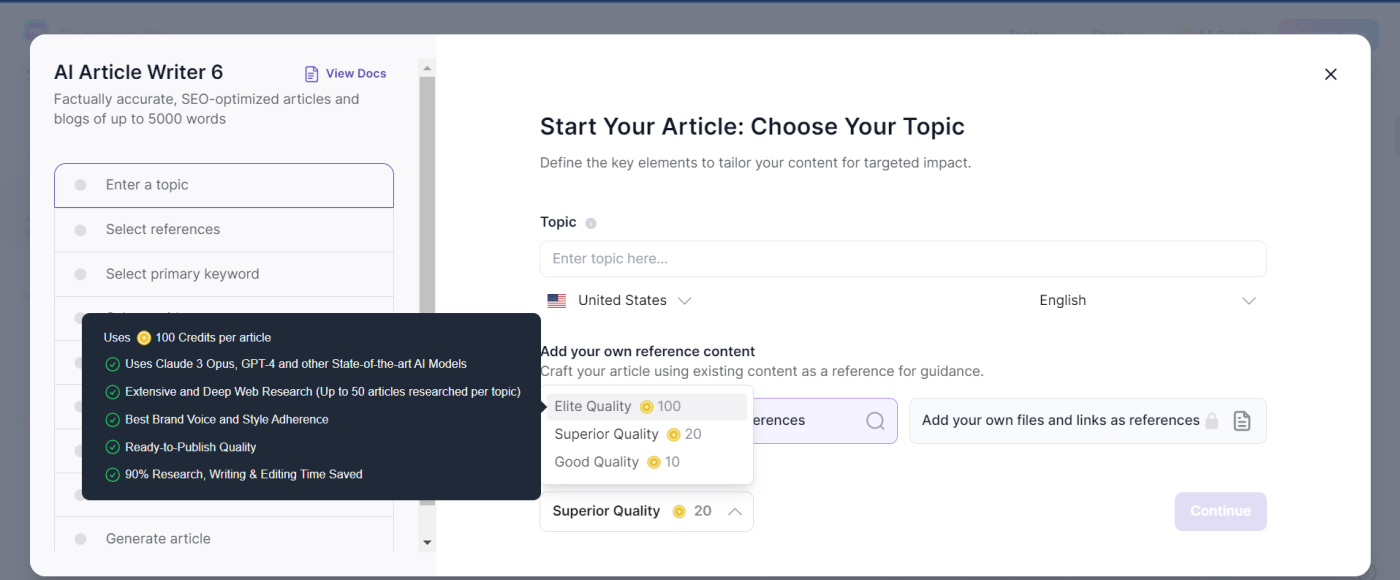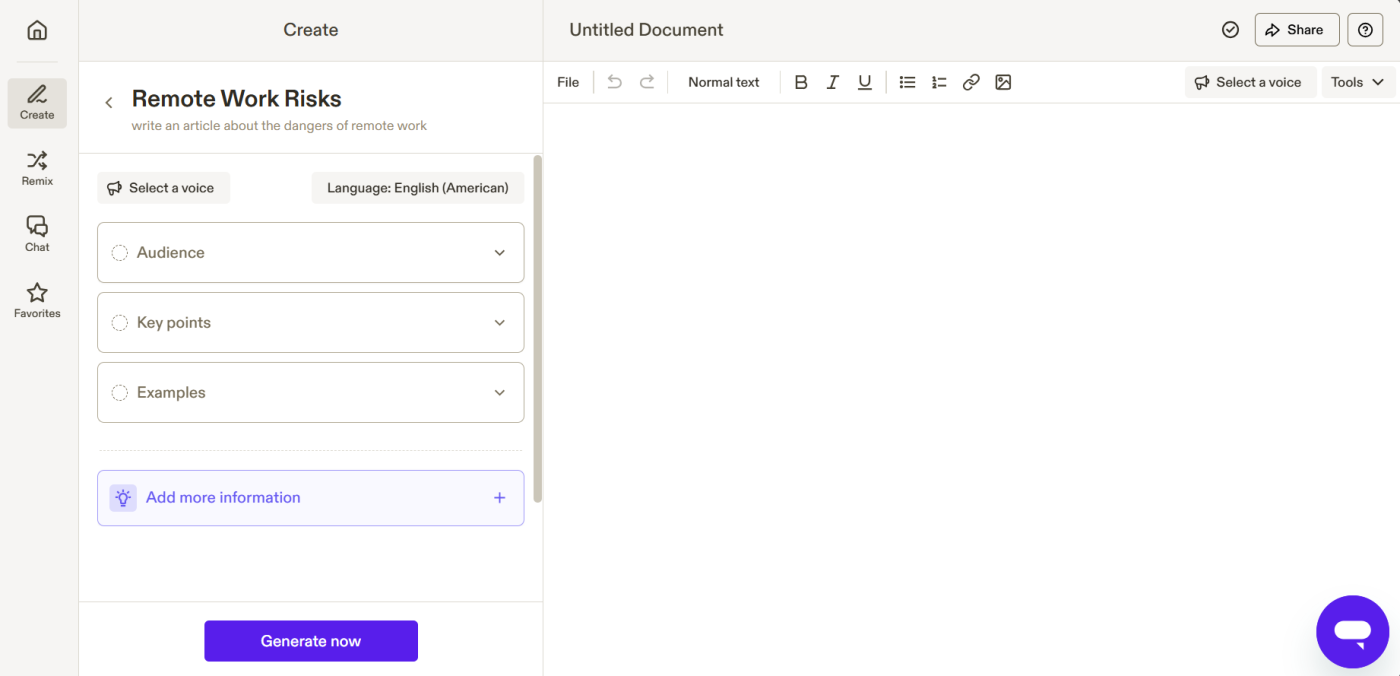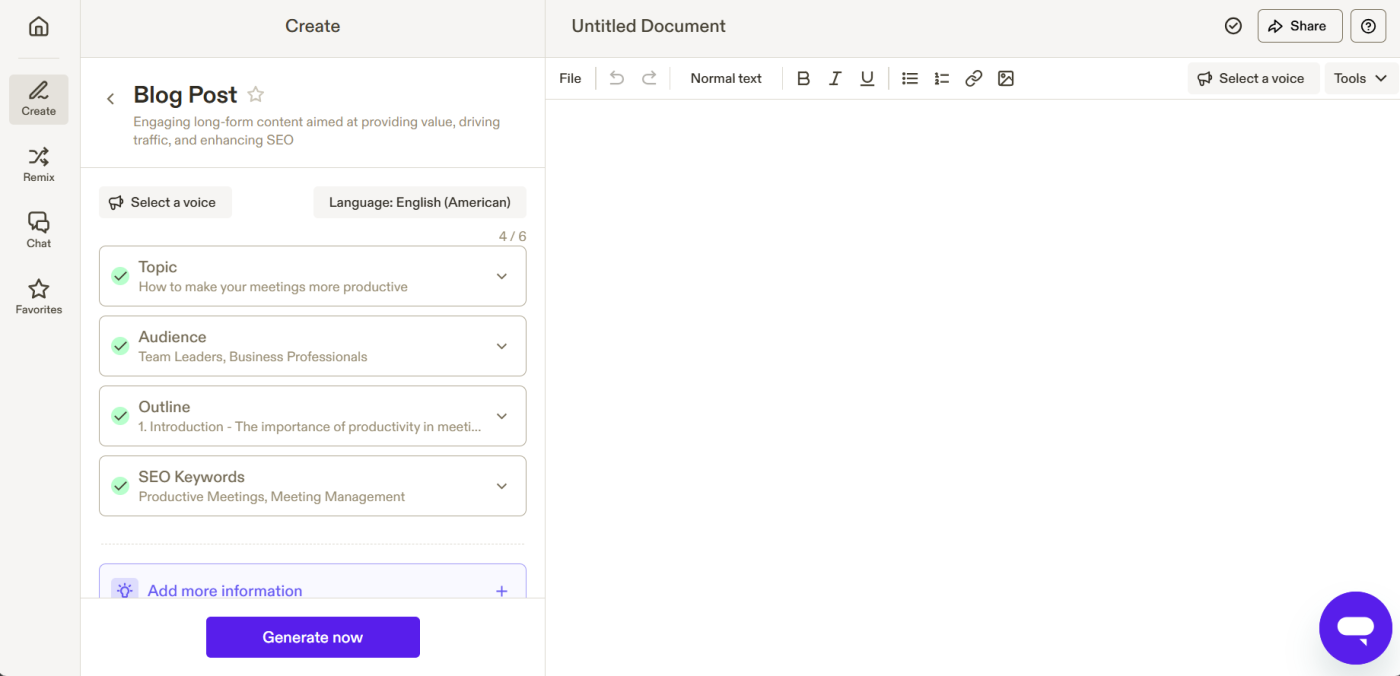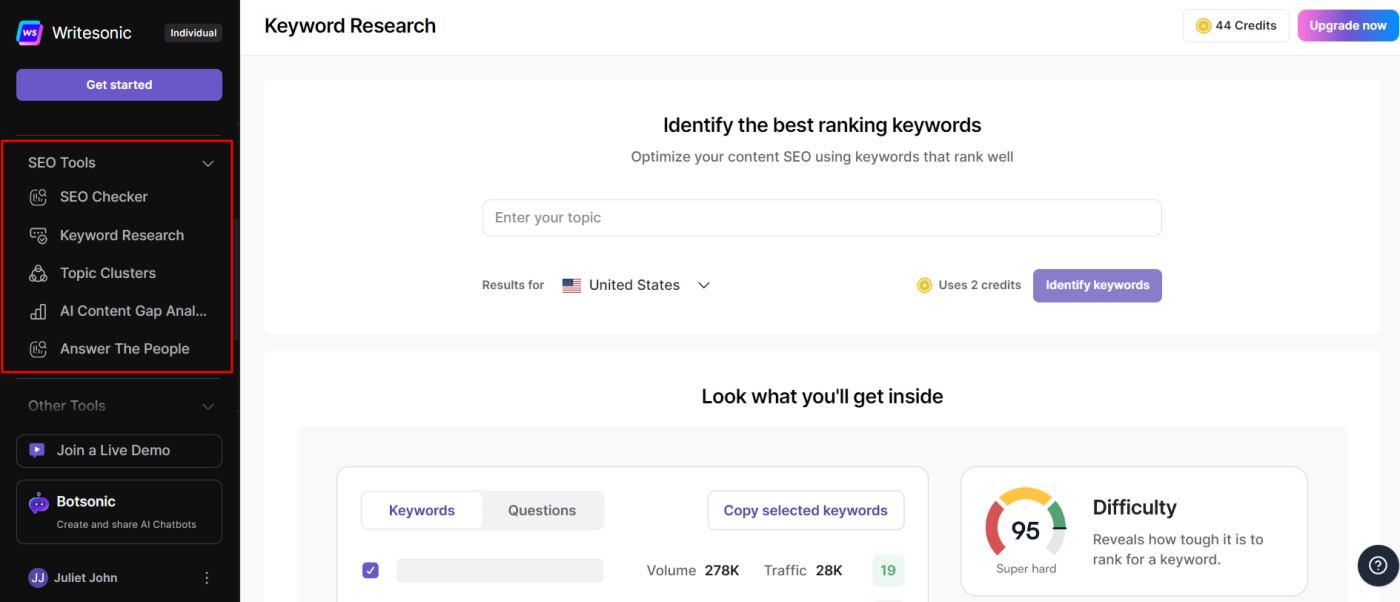I’ve been using Jasper regularly since 2021, and there’s no denying it’s one of the best AI writing tools on the market. But recently, I decided to try out another AI content tool: Writesonic. As it turns out, it’s a solid Jasper alternative. Both apps produce quality content, but they approach the process differently.
I compared these two apps last year, but a lot has changed since then. So I spent more time digging deeper into each one to see how they’ve changed and how their features and workflows stack up. Here’s what I discovered in the Jasper vs. Writesonic showdown.
Writesonic vs. Jasper at a glance
Here’s the gist: if you want more personalization and control over the content output you get, Jasper is the way to go. It has some excellent templates to work off of, but it also lets you go freeform a lot easier—that flexibility can be really important in the content creation process. That said, Writesonic serves a very clear purpose: its templates and workflow will help you go from ideation to finished content very quickly, including optimizing for SEO. Read on for more details from my experience using both apps.
|
Jasper |
Writesonic |
|
|---|---|---|
|
Templates |
⭐⭐⭐⭐⭐ 50+ solid templates |
⭐⭐⭐⭐⭐ 80+ templates |
|
Ease of use |
⭐⭐⭐⭐ Easier to use due to fewer features |
⭐⭐⭐ Also easy to use but can be overwhelming at first due to extensive options |
|
SEO tools |
⭐⭐⭐⭐ Integration with SurferSEO (requires additional subscription) |
⭐⭐⭐⭐⭐ Has a suite of built-in SEO tools |
|
Customization and flexibility |
⭐⭐⭐⭐⭐ Allows you to fine-tune the AI workflow to suit your needs |
⭐⭐⭐ More rigid framework |
|
Integrations and supported platforms |
⭐⭐⭐⭐⭐ Integrates with Zapier, Surfer SEO, Copyscape, DALL-E, and Webflow |
⭐⭐⭐⭐⭐ Integrates with Zapier, DALL-E, and WordPress |
|
Pricing |
⭐⭐⭐⭐ No free plan and high starting price |
⭐⭐⭐⭐⭐ Freemium model with entry-level pricing |
Jasper and Writesonic are powered by different AI models, but the output quality is similar
Jasper and Writesonic are both using OpenAI’s updated GPT models as part of their AI engines, but they’ve also both pulled in other LLMs (large language models) and even their own proprietary models.
Jasper is very transparent about the LLMs it uses (including models from Google, Anthropic, and Cohere), while Writesonic doesn’t prominently disclose the models that make up its AI engine (though I did notice that Writesonic mentions using Claude 3 Opus and GPT-4 in one of its templates).

Instead, Writesonic describes its AI engine as model-agnostic, meaning it picks the best combination of models for every use case (Jasper does the same thing).
The point here: both apps use state-of-the-art AI models, so output quality isn’t going to be drastically different for either one. As I was testing, I never noticed any significant difference in content quality.
Jasper is easier to use
Writesonic and Jasper have nearly identical interfaces: both have a left navigation pane full of features, with by a search bar and templates on the right. Here’s a look (Jasper on the left, Writesonic on the right):

Even though they look similar, I find Jasper to be more intuitive and generally easier to use, especially for creating long-form content.
To start writing an article in Jasper, specify your topic in the search bar, and click Create, or search for a blog template. Either way, Jasper will open up a simple editor with a structured workflow for creating your article.

The editor forces you to provide the details a solid content marketer should be thinking about anyway: target audience, key points you want to highlight, examples, and case studies to drive your point home. You can provide details not included in the template by clicking Add more information. Once you’ve supplied all the details the AI needs, click Generate now, and Jasper will generate a long-form article for you. It’s all very straightforward.
The process is more complicated in Writesonic. For starters, navigating to the “Article Writer” template from the left panel or searching for “article writer” in the search bar will surface multiple templates, each with different features.

Each template uses a different content workflow. (For example, Article Writer 4 relies solely on ChatGPT’s knowledge, while Article Writer 6 can conduct in-depth web research or use your uploaded company information.) That’s not a bad thing since it gives you flexibility, but it means that choosing a template can be very confusing (especially the first time). And if choosing a template isn’t easy, the road ahead is likely to be bumpy.
The advanced templates also use an expensive credit system (more on this later), exclusive to higher-tier plans. While some users may appreciate this workflow, I found it complicated, especially since AI content generation is all about speed.
Jasper is more flexible and offers more control
Both Writesonic and Jasper have an impressive selection of pre-bundled templates that can handle the entire content creation process. But Jasper’s offers more flexibility and is a huge asset for advanced marketers who prefer to be more involved in the process. And arguably, humans should be more involved in the process.
As I mentioned above, asking Jasper to create a blog post or searching for the blog template will open the editor, where you can furnish Jasper with details like the target audience, key takeaways, keywords, expert insights, and even your content outline.

As the AI tool writes, you can control the outputs, add context, and direct it on what to do—or not do—with prompts. Hit Stop generating, and Jasper will stop writing immediately. As you review the generated content, you can highlight sections and ask Jasper to rework them.

You can also instruct the AI to write in a specific style, incorporate examples, or grab insights from your website. Once you’re ready to resume writing, just click Continue writing in the doc. This whole process of writing alongside Jasper takes some practice, but once you get into it, you’ll be impressed by the level of personalization and creativity you can unlock.
Writesonic offers a similar workflow, but I didn’t find it as seamless as Jasper. Both tools also allow you to teach the AI your brand tone and key company details so it can use the information to create factual and on-brand content every time you run a template. With Jasper, I noticed a big difference when I used the brand voice feature—with Writesonic, it didn’t change much. It’s possible this was unique to my inputs, but it was a noticeable difference for me.
Finally, Jasper has a style guide feature for your editorial guidelines. It can keep track of everything from punctuation to contractions that’ll help you keep things consistent. Of course, it’s not perfect, but it’ll produce outputs that feel more like you.
One last note: Jasper also offers more control in its AI art generator. You can specify the mood, style, and medium you want your art in—it prompts you to get specific. If you want Jasper to draw inspiration from Pablo Picasso or Norman Rockwell, just choose from the list of famous artists and painters. You can specify this kind of detail in your prompt when using Writesonic (which uses the same AI image model), but Jasper helps you along by offering you a list. Jasper also always offers four outputs, so you have options.
Writesonic’s built-in SEO is more robust
Writesonic and Jasper both have SEO features to help you optimize your content for search engines. Jasper does it through an integration with Surfer SEO—requiring an additional subscription—while Writesonic’s SEO tools are built in.
Writesonic offers all the core features you want for your SEO: automated internal linking, an SEO content checker, keyword research, topic clusters, content gap analysis, and a search listening tool called Answer the People.

The SEO checker is integrated into the content editor to provide recommendations for enhancing your content as you write. Whether or not its SEO data and recommendations are accurate and relevant is for you to figure out—as is the case for any SEO tool. But having these features built in is a huge help. The only downside is that the SEO tools are only available on higher-tier plans and use the credit system, which can be expensive.
(While we’re talking about built-in tools, Writesonic also has an AI voice generator that can turn written content into human-like voiceovers. This can be great for running impactful and localized content campaigns.)
Both tools are pricey, but Writesonic has entry-level pricing
Writesonic and Jasper use different pricing structures, which makes it hard to compare them. Writesonic offers six plans that combine a credit and tiered system based on functionality; meanwhile, Jasper offers three simple plans based on functionality and number of users.
Let’s start with Jasper. It doesn’t have a free plan—just a seven-day free trial. Its cheapest plan—Creator—starts at $49/month but doesn’t include advanced features like knowledge assets, campaigns, or the Jasper art generator. Even the Pro plan for $69 excludes features like style guides, document collaboration, and custom workflows. You’ll need to speak with sales for a custom quote to enjoy unlimited access to the platform on the Business plan.
Writesonic, on the other hand, starts with a free forever plan—so if you need a free option, your decision is made. Its cheapest plan costs $15/month, but for that price, you won’t have access to any of its templates, brand voice features, or the AI photo generator. To unlock more features, you need to purchase higher tier plans, and the price scales to $99/month for small teams or solo marketers looking for full access to the platform. The professional and advanced plans are even more expensive, at $249/month and $499/month respectively.
For the individual plan at $20/month, Writesonic uses a credit system for advanced features and templates. The number of credits you get each month depends on your subscription plan, but you can purchase additional credits for $10 for 100 credits if your allotment runs out.
If you’re a freelancer, blogger, or business on a budget, Writesonic is your best bet for pricing. But when control and flexibility matter, Jasper has more value to offer.
Both apps have some native integrations and connect to Zapier
Writesonic integrates with DALL·E for image generation and connects to WordPress in one click. Jasper, on the other hand, integrates with Surfer, DALL·E, Copyscape, and Webflow.
That said, they both integrate with Zapier (though, on Jasper, you’ll need to buy the Business plan to access this integration, whereas Writesonic offers it on all plans).
Writesonic’s Zapier integration lets you kick off workflows straight from Writesonic. Learn more about how to automate Writesonic, or try the pre-built workflows below.
Jasper’s Zapier integration, on the other hand, works the other way around—you can kick off workflows in Jasper (create a blog post or product description, run a command, or summarize content) from all the other apps you use most. Learn more about how to automate Jasper, or try one of the pre-built workflows below.
Zapier is a no-code automation tool that lets you connect your apps into automated workflows, so that every person and every business can move forward at growth speed. Learn more about how it works.
Jasper vs. Writesonic: Which should you use?
Either Writesonic or Jasper would be a great addition to any content marketing tech stack, but they’re ideal for different scenarios. Jasper is better for experienced marketers with a budget, who want more control over the output. Writesonic serves more inexperienced marketers who need some hand-holding (and don’t have a budget)—and it’s the best choice if you want to be sure your AI writing tool has built-in SEO.
Related reading:
This article was originally published in April 2023. The most recent update was in June 2024.